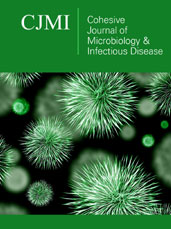- Submissions

Full Text
Cohesive Journal of Microbiology & Infectious Disease
Fight Against Antimicrobial Resistance: An Opinion
Dr. Shashank Sharma*
Department of Physics, Naveen Govt Girls College Mungeli (Chhattisgarh) India, 495334
*Corresponding author: Dr. Shashank Sharma, Department of Physics, Naveen Govt Girls College Mungeli (Chhattisgarh) India, 495334
Submission: September 25, 2025;Published: October 23, 2025

ISSN 2578-0190 Volume7 issues 5
Abstract
Antimicrobial resistance remains a significant problem for plants in agricultural field. Its appropriate solution is essential for innovation, unlocking the immense potential for the future. This opinion article presents our perspectives on the potential for anti-quorum sensing drugs to overcome anti-resistance and the evolving needs of the future.
Keywords: Antimicrobial activity; Anti quorum sensing; Drug; Agriculture
A Brief Point of View
Antimicrobial resistance is constantly increasing among pathogens. One of the reasons is lack of proper use of medicines, meaning that excessive use of antibiotics is being used during agriculture and animal husbandry, leading to resistance in pathogens. This problem of antimicrobial resistance is more problematic than it looks. Because in future, there will be no effective remedy for simple wound to prevent infection. For this, we need to find new treatments, that is, some such medicines which, if they do not directly target the survival of the bacteria and instead affect its pathogenicity, then perhaps it will develop less resistance because its life i.e. survival will not be affected, rather pathogenicity, which is a part of its life, will only be a problem. So, it is possible that we can overcome anti-microbial resistance. One of the interesting targets being studied from many decades, is quorum sensing. It is bacterial cell density dependent cell-cell communication. By using quorum sensing, bacteria produce such products that are needed in bulk. Pathogen use it to regulate their virulence factors responsible for pathogenicity. So, what should we do? If we target quorum sensing, then the bacteria will not die, but the pathogenicity of the bacteria will be controlled and, in this way, we can kill its infection without affecting their survival directly. Instead, the host environment will automatically kill the pathogen; because pathogen will not be able to control the host defense system. Or combined medicines can also be used which work better than the earlier antibiotics by using them along with anti-quorum sensing agents. Finding such strategies may help to overcome the global problem of antimicrobial resistance [1].
Future Directions
Five main points outline future directions for decreasing antimicrobial resistance:
a) Programs for Antimicrobial Stewardship (ASPSs): Encourage hospitals and other healthcare facilities to use antibiotics responsibly. Establish policies and procedures to stop doctors from abusing antibiotics. Based on diagnosis and response, choose the right antibiotics and how long to take them.
b) Public education and awareness: Spread knowledge about antimicrobial resistance and appropriate antibiotic use among the general public, doctors, pharmacists and other healthcare professionals. To avoid infections, encourage hand-washing and other personal hygiene habits. Use public education initiatives to dispel myths.
c) Infection control and prevention: Strict regulations and hygienic practices should be put in place to prevent infections in hospitals. Make sure that hand-washing and sanitization are effectively followed. Encourage immunization to lower the risk of infection.
d) Development of new antimicrobial drugs and vaccines: Encourage the development of new antibiotics, vaccines and treatment technologies. Use vaccines to prevent as many infections as possible, there by reducing antibiotic use. Improve drug delivery systems to ensure better delivery of drugs to patients.
e) Controlling the use of antibiotics in agriculture and animal husbandry: Ban the use of medically important antibiotics in animal husbandry and agriculture. Adopt vaccines and other alternative methods for animal treatment to reduce antibiotic consumption. Educate farmers about the correct use of antibiotics and their harmful effects. Thus, antimicrobial resistance can be effectively reduced through the combined efforts of all stakeholders at the societal level, such as the medical field, pharmacists, farmers, policymakers and the public [2-3].
Conclusion
In conclusion, the implementation of antimicrobial materials is the way of the future for the prevention of infections. In the fight against antibiotic or antimicrobial resistance in particular, it is expected that these advancements will be crucial in addressing global health issues as research continues to push frontiers.
Acknowledgement
I express my heartfelt gratitude to all the research article sources listed in the reference list, which inspired me to write an opinion article on this multi-purpose and socially useful topic.
References
- Shashank S, Sanjay KD (2024) Recent trends on antimicrobial properties in material science & nanotechnology: An opinion. Cohesive J Microbiol Infect Dis 7(3): 1-3.
- Shivali S, Sanjit K, Pankaj K, Vibhay NT (2024) Quorum sensing in gram-negative pathogens, a fresh look. The Microbe Volume 4: 100108.
- (2023) Antimicrobial resistance. World health organization, India.
© 2025, Dr. Shashank Sharma. This is an open access article distributed under the terms of the Creative Commons Attribution License , which permits unrestricted use, distribution, and build upon your work non-commercially.
 a Creative Commons Attribution 4.0 International License. Based on a work at www.crimsonpublishers.com.
Best viewed in
a Creative Commons Attribution 4.0 International License. Based on a work at www.crimsonpublishers.com.
Best viewed in 







.jpg)






























 Editorial Board Registrations
Editorial Board Registrations Submit your Article
Submit your Article Refer a Friend
Refer a Friend Advertise With Us
Advertise With Us
.jpg)






.jpg)














.bmp)
.jpg)
.png)
.jpg)










.jpg)






.png)

.png)



.png)






